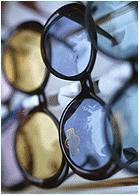Sunglasses to Protect Eyes
 It's extremely important to protect
your eyes from the sun. An inexpensive pair of sunglasses will do the job for
most people.
It's extremely important to protect
your eyes from the sun. An inexpensive pair of sunglasses will do the job for
most people.
The sun produces many different kinds of light, these most likely will cause injure to the eyes, they are listed below:
- Ultraviolet (UV) radiation, which is invisible and is often referred to as UV rays
- Bright or intense light
- Blue light
Wear Sunglasses to Protect Your Eyes
Wearing sunglasses to protect your eyes makes sense. It is safer to drive while wearing sunglasses, as sunglasses reduce glare and improve contrast in bright sunlight.
Choosing the Right Sunglasses
Choose sunglasses with lenses that are dark enough to keep your eyes comfortable, but not so dark that they reduce your vision. If you spend a lot of time outdoors in intense glare from sunlight bouncing off snow or water, you should wear sunglasses that block blue light. Medium to dark lenses with a gray, or a slightly brown or a green tint, will filter out most blue light.
Most sunglasses have plastic lenses. These lenses are tougher than glass and less likely to shatter. If you buy plastic lenses, look for a pair with a scratch-resistant coating. Check the lenses for distortion by putting the sunglasses on and looking at a rectangular pattern, such as floor tiles. If the lines stay straight when you move your head up and down, and side-to-side, then the amount of distortion is acceptable.
Sunglasses are made with different types of lenses to meet different needs:
- Regular lenses reduce the brightness of everything evenly
- Polarizing lenses are designed to cut glare due to reflection, this means they are good for driving and outdoor activities in the snow or on water
- Photo chromic lenses change with the intensity of UV light by turning darker when outdoors and lighter when indoors. If you wear these for driving, choose sunglasses that are fairly dark
- "Flash" or mirror lenses reflect all or part of the light instead of absorbing it. They offer no performance advantage as they scratch easily. You should choose a pair with a scratch-resistant coating
You can not tell how much UV protection a pair of sunglasses will provide unless reading the label which does list the type and amount of protection. Manufacturers follow standards when labeling sunglasses. Sunglasses that comply with standards are grouped in three categories:
- Cosmetic sunglasses have lightly tinted lenses for use in sunlight
that is not harsh. They block from 0 to 60 percent of visible light and UV-A
rays and between 87.5 and 95 percent of UV-B rays. These glasses are not
usually recommended for daylight driving
- General purpose sunglasses block from 60 to 92 percent of visible
light and UV-A rays and between 95 and 99 percent of UV-B rays. These
sunglasses are good for driving, and are recommended whenever sunlight is harsh
enough to make you squint
- Special purpose sunglasses block up to 97 percent of visible light and up to 98.5 percent of UV-A rays. They also block at least 99 percent of UV-B rays, and are suitable for prolonged sun exposure. These sunglasses are not recommended for driving

